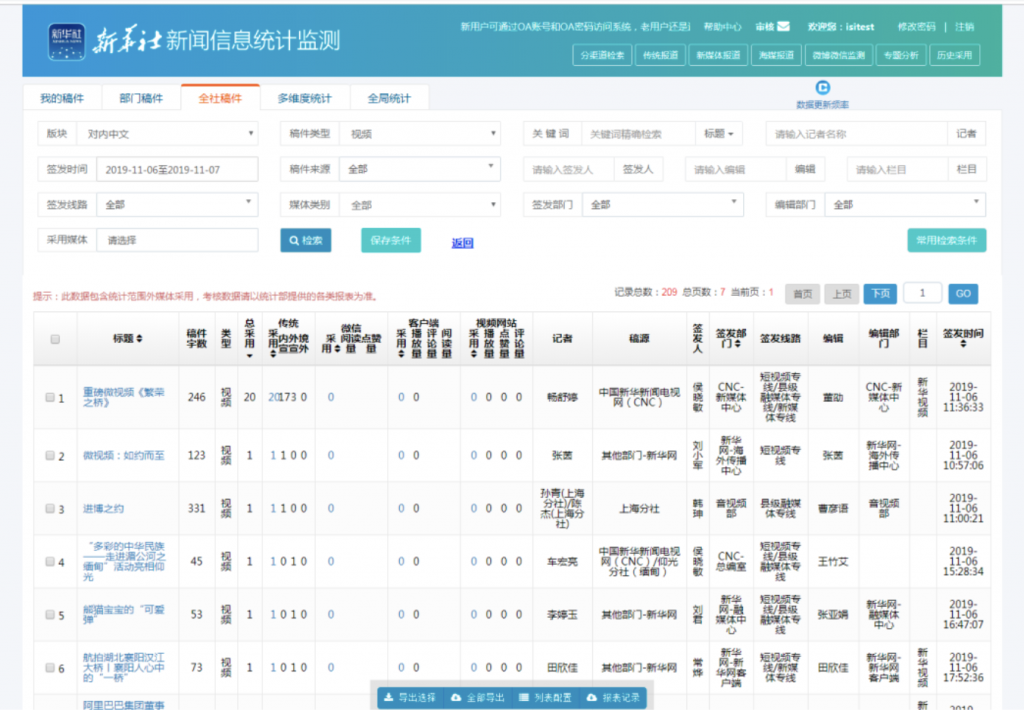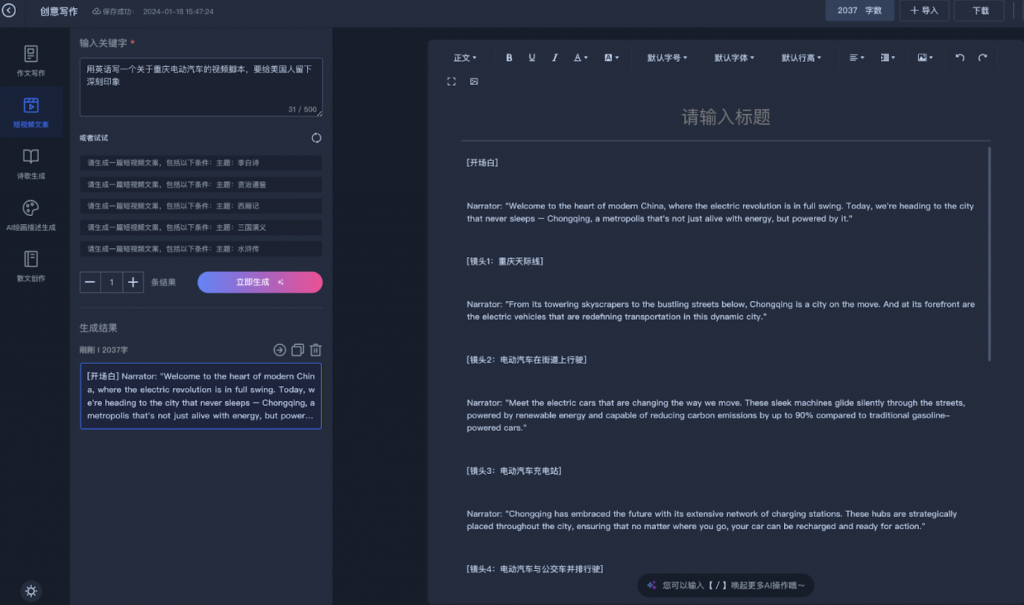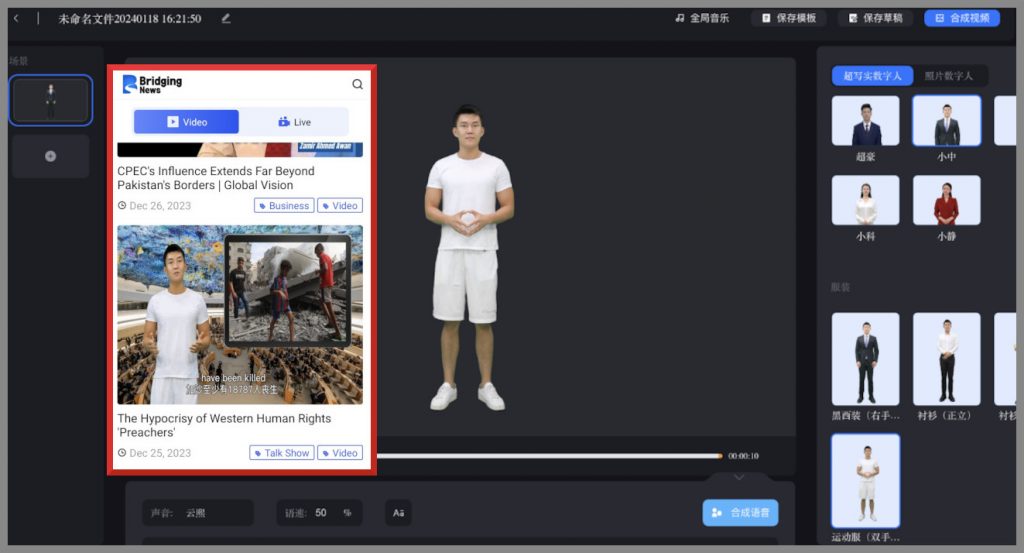
Since ChatGPT was unveiled to the world just over two years ago, prompting what some have called an “artificial intelligence revolution,” China has been playing catch-up. But when it comes to applying AI to super-fuel the media control and propaganda objectives of the government, both at home and overseas, China may be ahead of the game — even if the results so far are mixed.
For a closer look at China’s plans for AI-driven propaganda and messaging, we spent a bit of time with Zhongke Wenge (中科闻歌), a company touted in China Daily as having “established a panoramic international communication” system, integrating AI-based news gathering, content production, editing, and impact analysis. Zhongke Wenge is one of a growing number of companies in China offering AI-based communication services to answer the call of the Chinese Communist Party (CCP).
Back in 2018, President Xi Jinping identified it as a “necessary” mission for the CCP “to develop artificial intelligence systems suitable for government services.” Two years later, a set of opinions from the Party’s Central Committee urged media specifically to use AI to improve the quality of their content, innovate new ways to tell the news, and integrate the Party’s messaging into both domestic and international outlets. Last year, CCP mouthpiece People’s Daily highlighted how AI can use big data to generate images, text, and in-depth analysis “in seconds,” and this month urged the development of “AI-aided translation software” to assist with outreach overseas.
Established by three researchers from the Chinese Academy of Sciences and chaired by a member of the National Development and Reform Commission, Zhongke Wenge is turning this call into an enviable revenue stream. As of August 2023, it claimed total assets worth 1 billion RMB ($140 million), with an array of shareholders including state-owned funds and enterprises.
What exactly can Zhongke Wenge do, and what are its limitations?
Using AI to “Tell China’s Story Well”
The company says it offers “long-term services” to the Central Propaganda Department, the Ministry of Public Security, CCTV, Xinhua, and People’s Daily. Chinese media have noted that it offers “technical services” such as “data analysis and modeling of countries along the Belt and Road” and has provided “minority language modeling” and “external publicity modeling” for the Ministry of Foreign Affairs, China Daily, and Hong Kong’s CCP-backed Ta Kung Wen Wei Media Group. It claims its tools to “assist content creation” have shortened production times at news companies by 15 percent, while its “assisted decision-making” tools allow platforms to gauge how their stories are being received, both at home and abroad.
Zhongke Wenge also claims its multi-lingual monitoring system caters to government and state media that face “difficulty [in] guiding international public opinion.” It does this by harvesting information from both domestic and international media, as well as prominent individuals, in 42 different languages. This allows the “timely warning of China-related public opinion” and recommendations on how to “tell China’s story well.”
People’s Daily has collaborated with Zhongke Wenge to create a “People’s Public Opinion Cloud” that the newspaper claims has been used by local police to help them quickly spot “sensitive data” and trace its origins, while provincial media have used it to spot news leads. Zhongke have also teamed up with Xinhua to create a “News Statistics Monitor” showing how often a certain article has been published domestically and abroad, how often it is liked on WeChat, and how many times the article was “commented on” online. Zhongke claims to have saved Xinhua’s Statistics Department 10 million RMB.

Gauging international opinion on China is a top priority for China’s propaganda apparatus, but never before have these been combined with big data on single online platforms, accessible to any official or editor in the country. Zhongke also offers a content creation suite for overseas audiences, giving AI-generated video scripts and filming directions from a single prompt and the click of a button.

On Zhongke Wenge’s content creation platform, we did just that. After we input a text prompt in Chinese to their “short video copywriter,” we got a full script about the electric car industry in the inland megacity Chongqing, complete with suggested camera shots. The site also offers AI anchors, who will read out (in a selection of different voices and with a variety of different gestures) whatever you type. China Media Project took the system for a test drive, producing this video in under 15 minutes:
Quantity Over Quality
One of Zhongke’s listed clients is iChongqing, part of the city’s international communications center (ICC). These centers, which respond to instructions issued by Xi Jinping in August 2018, are central to China’s latest efforts to restructure its external propaganda apparatus. According to our research at CMP, at least 20 ICCs have opened in various provinces and other jurisdictions in China since 2022. iChongqing’s AI anchors now front the outlet’s anti-US explainer videos on their app “Bridging News” (which, at the time of writing, has been downloaded over 100,000 times on Google Play).
Zhongke Wenge’s unsettling AI anchors are a testament to the difficulty of manufacturing creativity, innovation, and “lovable” messages by machine. Ultimately, its products are more useful in turning the propaganda mill up a notch, pumping up the sheer quantity of positive messaging, and in giving crucial feedback to create more targeted messaging that is more likely to win hearts and minds abroad.

And this is just one company. Separate investigations in January into video content in French, and in Chinese ahead of the Taiwanese elections found a trove of videos posted on Western social media that used AI-generated voices and anchors to spread pro-China and anti-US disinformation in a way designed to sway public opinion. At least 100 videos using AI-generated content appeared on YouTube about “The Secret History of Tsai Ying-wen” (蔡英文秘史), a 300-page book filled with disinformation about the Taiwanese president’s personal life. Some of these videos were being shared 100 times a minute.
While these investigations have not directly implicated Zhongke, its content-creation software does present a double threat: It is both highly accessible — freely available for any WeChat users to create and share videos — and difficult to trace, since videos do not include any markers. These features make it a valuable tool not just for state-level actors but also for individual internet users looking to smear China’s perceived enemies and further muddy the waters of online discourse, where the line between what is and is not real continues to dissolve.




















